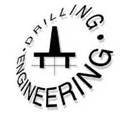 EXERCISE 2 Pressure loss in Laminar Flow
EXERCISE 2 Pressure loss in Laminar Flow
a. Calculate the velocity of a fluid flowing through a 5" 19.5 lb/ft drillpipe (I. D.= 4.276") at 150 gpm.
b. Determine the pressure loss in the above situation if the fluid is a Bingham Plastic fluid with a plastic viscosity of 20 cp, a yield point of 15 lb/100 sq. ft and density is 10 ppg.
c. Calculate the pressure loss in the above situation if the fluid was a Power Law fluid with an non-Newtonian Index of 0.75 and a consistency index of 70 eq cp
|
|
When the drilling fluid is pumped at a high rate the fluid laminae become unstable and break into a chaotic, diffused flow pattern. The fluid is then in turbulent flow. The transfer of momentum caused by this chaotic fluid movement causes the velocity distribution to become more uniform across the centre portion of the conduit than for laminar flow. However, a thin boundary layer of fluid near the pipe walls generally remains in laminar flow. A schematic representation of turbulent pipe flow is shown in Figure 12.
|
Velocity Profile |
|
|
v avge. |
|
Figure 12 Turbulent Flow Profile In Pipes
A mathematical development of flow equations for turbulent flow has not been possible to date. However, a large amount of experimental work has been done in straight sections of circular pipe and annuli, and the factors influencing the onset of turbulence and the frictional pressure losses due to turbulent flow have been identified.
4.2.1 Determination of Laminar/Turbulent Boundary in a Non Newtonian Fluids
An accurate turbulence criteria, in other words the point at which the flow theoretically changes from Laminar to Turbulent flow, is required for non-Newtonian fluids. In the case of Newtonian fluids this determination is based on the Reynolds number. However, since there is no single parameter that defines the rheological properties of a Non-Newtonian fluid, such as the Newtonian viscosity, we have to establish an apparent Newtonian viscosity for the Non — Newtonian fluid. The second problem is that in the case of of annular flow there is no single value for pipe diameter in the above equation.
